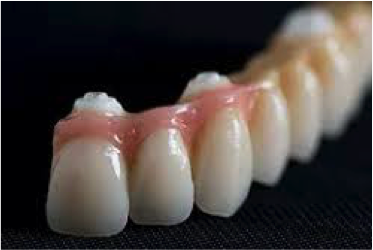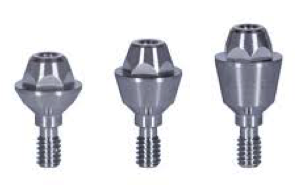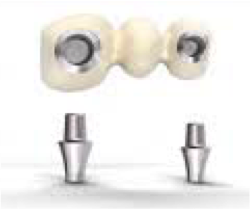Bridges on implants, with engaging or non-engaging abutments
Replacing a single tooth with an implant is a common procedure nowadays, and an everyday activity in most practices and laboratories. Using implants to replace several missing teeth in a row, on the other hand, is more than a simple sum of its parts. The physical rules and constraints normally applying to single-tooth dental restoration also come into play in the creation of a fixed multiple prosthesis, although there are some added particularities characterizing this type of treatment.
This segment will discuss abutments specially designed to anchor dental bridges to implants.

A single tooth implant has to be prevented from rotating. The reason for this is self-evident; a central incisor cannot work like a revolving door. In the case of a bridge, however, rotation is made impossible by the multiple anchor points.
Could we still block the rotation on each implant unit used to support a bridge? After all, it would seem logical to use individual abutments to complete a bridge. As it happens, this approach is not really recommended.

When there are several consecutive teeth to be replaced, it is already complicated to secure a good fit, so if each new unit has to match the anti-rotation systems of the implants, this just magnifies the possibilities of problems arising, and the resulting risk of failure. As no anti-rotation is required on two or more teeth, the bridges in this case call for a special type of abutment. All individual manufacturers have such components in their catalogues. Some have based their solution on direct contact with the implant itself, notably on the case of non-engaging titanium bases; these are increasingly common on the market, although others have gone with a secondary, usually conical, abutment.

If there are no secondary abutments, the abutments directly connected to the implants will not only be non-engaged but will also be less deeply set in the implant, thus avoiding the possibility of a divergence between implants.
If the relative angle of the implants varies appreciably, say by 25 to 30 degrees, inserting an intermediate conical abutment would optimize the placement of a bridge anchored to implants that are not aligned. Because the walls of the cone are slanted, they can better accommodate divergences between implants.

Some, although not all, of these abutments are designed to lock into the implant. The emerging conical portion is usually the component without this anti-rotation feature.

For this reason, it is best to install intermediate abutments in the mouth beforehand, and to tighten them down to the manufacturer’s stated torque. A final impression can then be taken with transfer cylinders custom-fitted to the intermediate abutments. The prosthetist will use the appropriate replicas, and the bridge can be fashioned on a precise model. There is also no concern as to the tightening torque on anchoring abutments since they will already have been tightened into the bone.
Of course, there will be a number of situations in which the technician will install intermediate abutments on the working model. In such cases, it is important to make sure each abutment is tightened at least equally, if not to the recommended torque. This procedure must then be repeated in the patient’s mouth. The thing to remember is that no abutment can be tightened more, causing it to set deeper than any other.

The foregoing procedures concern screw-retained prostheses. If, on the other hand, you want to cement a bridge onto the abutments without any access to the retaining screws, you should definitely use the same abutments as for single-tooth restorations, since the cementation principle will be the same as for a conventional bridge cemented onto natural preps.
The cementation in situalso gets around the problem of screw access holes, which would otherwise be visible. The holes accessing individual screws can be anywhere, as the bridge will eventually cover everything over anyway.
In most cases, it will be preferable to use custom-made custom-fit single-unit abutments. This will provide the parallelism required for anchoring the bridge, regardless of where the implants are positioned in the jaw.





